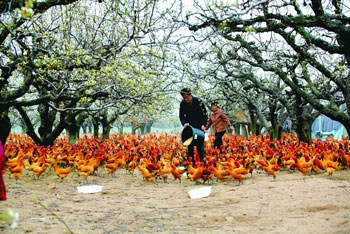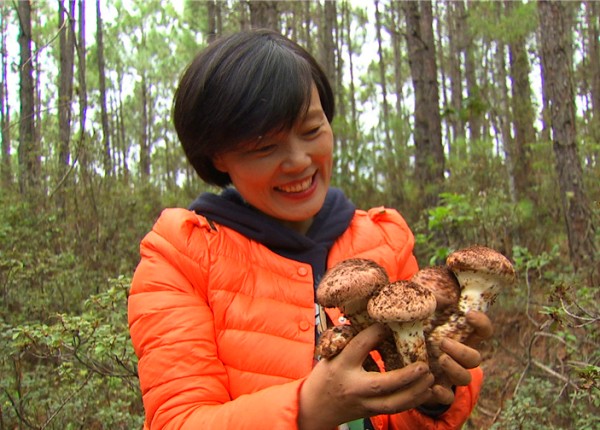The chicken running away from the yellow pear orchard to recover the cost in the short term.

In late autumn, corn grains have already returned to the warehouse, and wheat has also grown inch-long seedlings. In Funan County Longwang Township Yuanlu Village Chuangyi planting and breeding professional cooperative yellow pear planting base, 200 mu of late autumn yellow pear hanging fruit for the first time this year, the harvest season has just begun.
200 mu of yellow pear hanging fruit for the first time
Walking about 400 meters to the west from the Longwang section of provincial highway 202, one after another rooster crowing in the pear forest was heard from afar, and the bagged late autumn yellow pear loomed among the thick branches and leaves.
"this year is the first time to hang fruit. The highest yield per mu is 2000 jin. Now the wholesale price is 2.51 jin. Dai Xianchun, head of Chuangyi planting and breeding Professional Cooperative, told me that the 200 mu of late autumn yellow pears were planted in November 2012 and have begun to see benefits this year. Judging from the current harvest, the total output this year should be about 200000 jin. At present, the cooperative has to hire more than 30 workers to pick and pack them every day. The yellow pears picked can usually be sold out on the same day, and demand exceeds supply in the Lu'an market.
"this year is the first time to hang fruit. Only six or seven fruits have been kept on a tree in order to ensure the normal growth of the tree. According to Dai Xianchun, the trees of these 200mu of late autumn yellow pears are only four years old and have just entered the period of full fruit. there are few fruits left this year, and the output next year is expected to exceed 1 million jin.
Selenium-rich yellow pears sell well
At the Chuangyi planting and breeding Professional Cooperative, workers are busy loading packaged late autumn yellow pears into boxes with selenium-rich yellow pears, while a truck with a Liu'an license plate is waiting to be loaded.
"the merchants in Yu'an District have ordered more than 5000 jin of yellow pears, which are now loaded and can enter the wholesale market in the evening. Dai Xianchun told me that unlike villages and towns such as Miaoji and Lucheng, which mainly focus on Shanghai fruit wholesale markets, yellow pears from the cooperative are mainly sold to cities in the province. Prior to this, he signed an agreement on the sales intention of late autumn yellow pears with the four Seasons Green Ecological Agriculture Professional Cooperative in Yu'an District of Lu'an City. the wholesale price of selenium-rich yellow pears is 3 yuan per jin and ordinary yellow pears is 2.51 yuan per jin. Due to the application of organic fertilizer during the growth of yellow pear, the sugar content of yellow pear is as high as 13.8 except for the characteristics of large color, small kernel and no residue. Among them, the selenium content of selenium-rich yellow pear reaches 20Mel 22 micrograms per kilogram, which is 10 times that of ordinary pear. Its health effect is very obvious, and it is very popular in Lu'an market.
It is understood that the four Seasons Green Ecological Agriculture Professional Cooperative specially marks the brand and origin of late autumn yellow pears in the current spring on the packing box to facilitate the identification of consumers in Lu'an area.
High benefit of three-dimensional planting and breeding
While planting late autumn yellow pear, Dai Xianchun also interplanted watermelons and raised native chickens in the forest, which recovered the cost of land transfer in a short time and created higher economic benefits.
In the course of the interview, Dai Xianchun received calls from non-local merchants from time to time to order native chickens and eggs. "most of the more than 70,000 native chickens raised under the forest have been sold before and after the Mid-Autumn Festival, and native eggs will not be on the market for some time. Dai Xianchun told the reporter that the 4000 breeder chickens selected before could be bred a year ago, and the chicks hatched a year later picked out cocks to be scattered under the forest, while hens were raised in cages, which were mainly used to produce native eggs. At present, native eggs are very tight in the southern market, and many merchants call to order them every day, and some even ask for a part of the deposit to buy them at a high price.
It is understood that since the spring of 2013, Dai Xianchun has been interplanting watermelons in the yellow pear base and will be able to recover operating costs that year. "the watermelons, chili peppers and green onions interplanted this year have been in short supply during the period of listing, with an additional income of 3,000 to 4,000 yuan per mu, excluding land transfer costs and labor costs, there is still a lot of surplus. "Dai Jianchun said.
Related
- A course of planting techniques and methods on how to grow carrots
- How to plant the latest tulips?
- Is it better to pick tea in the morning or in the afternoon? When is the best time for tea to be picked? what is the third or fifth tea?
- Launch Yuanxiao Happy combination Haocha + Tea Yuan healthy Taste
- Penghu Tourism "Fireworks 20 Parade with You"
- 2022 West Lake Happiness holds "Digital Revitalization Voucher" and draws iphone13 and laptop.
- Banqiao Fuzhou social houses are designed to change start-up combined with police elimination to create a safe and livable environment
- The convenient measure of "mechanical weeding" in Xinbei has been abused and the Agriculture Bureau has imposed heavy penalties on the illegal land consolidation.
- Changgeng University Joins Hands with Four Memory Factories to Rescue Memory Talent Shortage
- The list of Taiwan's top 100 MVP managers is listed by the Director-General of the Farmers' Association of Sanxia District.



